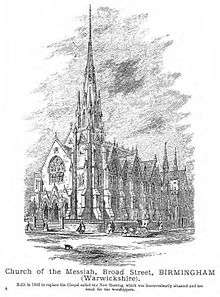Church of the Messiah, Birmingham
| Church of the Messiah | |
|---|---|
 Former Church of the Messiah, Broad Street, Birmingham. | |
| 52°28′41″N 1°54′40″W / 52.47792°N 1.91102°WCoordinates: 52°28′41″N 1°54′40″W / 52.47792°N 1.91102°W | |
| Location | Broad Street, Birmingham |
| Country | England |
| Denomination | Unitarian |
| Architecture | |
| Architect(s) | John Jones Bateman |
| Groundbreaking | 1860 |
| Completed | 1862 |
| Construction cost | £10,000 |
| Demolished | 1978 |
| Specifications | |
| Capacity | 950 people |
| Length | 106 feet (32 m) |
| Width | 65 feet (20 m) |
| Height | 150 feet (46 m) |
The Church of the Messiah, Birmingham was a Unitarian church on Broad Street, Birmingham.
History
The foundation of the congregation goes back to 1692 when the first meeting house was built, afterwards known as the Lower Meeting House, Deritend. When the congregation outgrew this in 1732, they moved into a new chapel in Moor Street. By the 1860s this was also too small so a new church was commissioned. The Moor Street chapel was sold to a Roman Catholic congregation, and became St Michael's Church.
The new Church of the Messiah was built to designs by the architect John Jones Bateman, the contractors being George Branson and Edwin Gwyther.[1] The foundation stone was laid on 11 August 1860 and the church opened on 1 January 1862,[2][3] at a cost of £10,000. The site was unusual in that it straddled the Birmingham Canal,[2] forming part of the Broad Street canal tunnel.
Early members of the congregation included members of the Martineau family[4] who would produce many Birmingham Lord Mayors throughout the 19th and 20th centuries.[5] Joseph Chamberlain,[2] and his son Neville Chamberlain, prime minister (1937–1940), attended services in this church.
The church was demolished in 1978.[2] The congregation moved to a new building at Five Ways, which opened on 1 September 1973.
Organ
An organ was provided by Nicholson of Worcester in 1862, but by 1882 the congregation had commissioned a new one from William Hill and Son at a cost of £1571.[6] This was rebuilt by Nicholson of Worcester in 1923. A specification of the organ can be found on the National Pipe Organ Register.[7]
Ministers
- John Sillitoe, 1692–1704
- Thomas Pickard, 1705–1747
- Samuel Bourn, 1732–1754
- Samuel Blyth, 1747–1791
- William Hawkes, 1754–1780
- Joseph Priestley, 1780–1791
- John Edwards, 1791–1802
- David Jones, 1792–1795
- John Kentish, 1803–1853
- Joshua Toulmin, 1804–1815
- James Yates, 1817–1826
- John Reynell Wreford, 1826–1831
- Samuel Bache, 1832–1868
- Henry William Crosskey, 1869–1893
- Lawrence Pearsall Jacks, 1894–1903
- John Worsley Austin, 1903–????
Organists
- John Gilbert Mills, ca. 1923
References
- ↑ The building contract and other related papers are held in the Library of Birmingham.
- 1 2 3 4 Bartlam, Norman (2002). Broad Street Birmingham. Sutton. ISBN 0-7509-2874-3.
- ↑ Birmingham Journal, Saturday 4 January 1862.
- ↑ Briggs, Asa. "Victorian Cities". University of California Press, 1965 - Page 202. Retrieved 24 July 2015.
- ↑ Wharton, Jane. "Kate Middleton is a Brummie and related to former prime minister". UK Daily Express - June 3 2015. Retrieved 24 July 2015.
- ↑ Pipes and Actions. Laurence Elvin. 1995
- ↑ National Pipe Organ Register